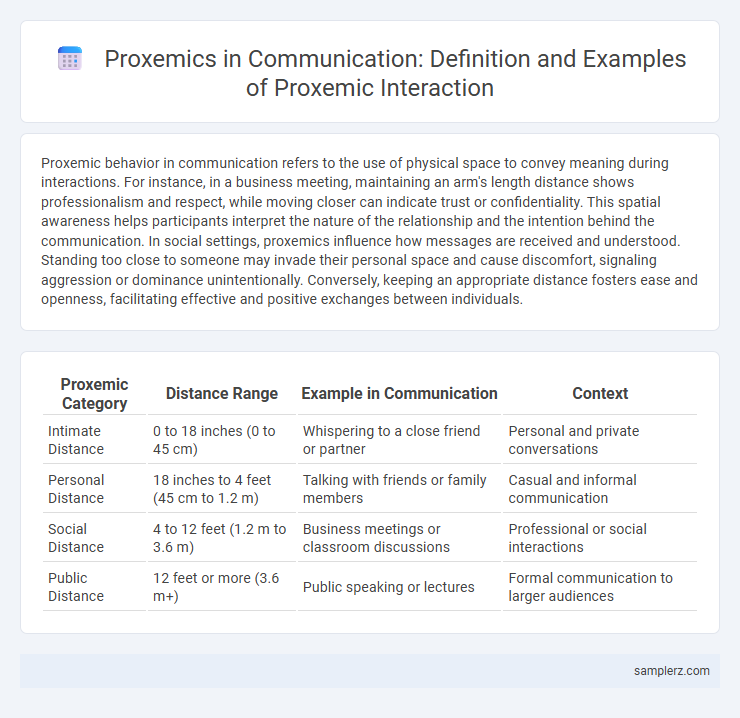Proxemic behavior in communication refers to the use of physical space to convey meaning during interactions. For instance, in a business meeting, maintaining an arm's length distance shows professionalism and respect, while moving closer can indicate trust or confidentiality. This spatial awareness helps participants interpret the nature of the relationship and the intention behind the communication. In social settings, proxemics influence how messages are received and understood. Standing too close to someone may invade their personal space and cause discomfort, signaling aggression or dominance unintentionally. Conversely, keeping an appropriate distance fosters ease and openness, facilitating effective and positive exchanges between individuals.
Table of Comparison
| Proxemic Category | Distance Range | Example in Communication | Context |
|---|---|---|---|
| Intimate Distance | 0 to 18 inches (0 to 45 cm) | Whispering to a close friend or partner | Personal and private conversations |
| Personal Distance | 18 inches to 4 feet (45 cm to 1.2 m) | Talking with friends or family members | Casual and informal communication |
| Social Distance | 4 to 12 feet (1.2 m to 3.6 m) | Business meetings or classroom discussions | Professional or social interactions |
| Public Distance | 12 feet or more (3.6 m+) | Public speaking or lectures | Formal communication to larger audiences |
Understanding Proxemics in Everyday Communication
Proxemics in everyday communication reveals how physical distance impacts interaction meaning, such as maintaining personal space during conversations to convey comfort or respect. For example, standing too close to a colleague in a professional setting can signal aggression or over-familiarity, disrupting communication flow. Understanding cultural differences in proxemic norms improves interpersonal effectiveness and minimizes misunderstandings.
Personal Space: Defining Boundaries in Social Interactions
Personal space in communication defines the invisible boundaries individuals maintain to feel comfortable during social interactions, usually ranging from 18 inches to 4 feet in casual conversations. Violating this proxemic zone can lead to discomfort, misinterpretation, or perceived aggression, influencing the effectiveness of interpersonal communication. Cultural differences significantly impact these personal space norms, affecting how physical distance is interpreted across various social contexts.
Proxemics in Professional Settings: Workplace Dynamics
In professional settings, proxemics shapes workplace dynamics by regulating personal space to maintain comfort and authority. For instance, managers often position themselves at a desk or a distance that asserts power, while peers use closer distances to foster collaboration and trust. Understanding these spatial cues enhances communication efficiency and reduces misunderstandings in office interactions.
Cultural Differences in Proxemic Behavior
In intercultural communication, proxemic behavior varies significantly, with some cultures maintaining close personal distances during conversations while others prefer more space, reflecting their cultural norms about privacy and respect. For instance, Latin American and Middle Eastern cultures often engage in close physical proximity, enhancing warmth and connection, whereas Northern European and East Asian cultures typically favor greater distances to preserve personal boundaries and formality. Understanding these cultural differences in proxemics is essential for effective cross-cultural interactions and avoiding misunderstandings in both professional and social settings.
Proxemic Cues in Nonverbal Communication
Proxemic cues in nonverbal communication include the use of personal space to convey intimacy, authority, or social distance. For example, standing within one to two feet signals familiarity and comfort, while maintaining a distance of four to twelve feet often indicates formal or professional interactions. Cultural differences significantly affect proxemic interpretations, making awareness of spatial behavior crucial for effective communication.
The Role of Proxemics in Public Spaces
Proxemics plays a crucial role in public spaces by regulating personal distance and spatial arrangement, which influences comfort and communication. For example, individuals maintain larger interpersonal distances in crowded parks compared to quieter areas, signaling boundaries and social norms without verbal cues. Understanding these spatial behaviors enhances the design of public spaces to foster positive social interactions and reduce discomfort.
Proxemic Distances: Intimate, Personal, Social, and Public Zones
Proxemic distances significantly influence communication effectiveness by defining spatial boundaries: intimate zone (0-18 inches) fosters close personal connections, personal zone (18 inches to 4 feet) suits conversations among friends, social zone (4 to 12 feet) supports interactions in professional or casual settings, and public zone (12 feet and beyond) facilitates address to larger groups. Understanding these zones enhances interpersonal communication by respecting comfort levels and cultural expectations. Misinterpretation of proxemic zones can lead to discomfort or perceived aggression during interactions.
Impact of Technology on Proxemic Interactions
Technology has reshaped proxemic interactions by altering traditional spatial boundaries through virtual communication platforms like video calls and social media. The decreased need for physical proximity enables more frequent but often less intimate exchanges, impacting how individuals interpret personal space cues. Emerging technologies such as augmented reality further blend physical and digital spaces, creating new dynamics in personal and social distances.
Adaptive Proxemic Behaviors in Different Situations
Adaptive proxemic behaviors in communication involve adjusting physical distance based on social context, such as standing closer during intimate conversations and maintaining more space in formal settings. Cultural norms heavily influence these distance preferences, requiring sensitivity to avoid discomfort or misinterpretation. Technology-mediated interactions often challenge traditional proxemic cues, prompting new adaptive strategies like virtual backgrounds and screen positioning to manage perceived spatial relationships.
Proxemics and its Influence on Relationship Building
Proxemics, the study of personal space in communication, significantly affects relationship building by regulating levels of intimacy and comfort during interactions. For example, maintaining appropriate physical distance in professional settings fosters trust and respect, while closer proximity in personal conversations encourages emotional connection and rapport. Understanding cultural variations in proxemic norms allows individuals to navigate social boundaries effectively, enhancing mutual understanding and relational development.

example of proxemic in interaction Infographic
 samplerz.com
samplerz.com